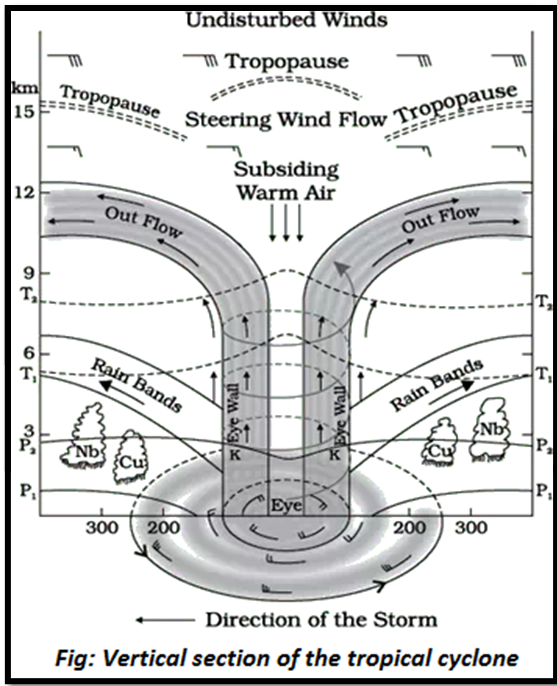TROPICAL CYCLONES OF HIGHER INTENSITY DEMAND A NEW CATEGORY
Syllabus:
- GS-1- Tropical and temperate cyclone from geography point of view
- GS-3– Disaster management like tropical cyclones
- GS-4– Case study on disaster management
Focus :
- Tropical cyclones with peak wind speeds far exceeding category 5 scale of 252 km/hour are increasingly seen due to global warming, making a case for introducing category 6 for wind speed above 309 km/hour
Source:- NCERT
Introduction
- These storms can cause significant damage to coastal communities and infrastructure.
| About Tropical cyclones :
· Tropical cyclones are powerful weather systems that form over warm tropical ocean basins. They are characterized by strong winds, heavy precipitation, and storm surges. Conditions favourable for formation of tropical cyclones : · Tropical cyclones develop and strengthen primarily over warm tropical oceans. · Favorable conditions include a large expanse of sea surface with temperatures exceeding 27° C. · The Coriolis force, a result of Earth’s rotation, is necessary for cyclone formation. · Minimal changes in vertical wind speed contribute to cyclone development. · A weak pre-existing low-pressure area or cyclonic circulation at lower levels is conducive to cyclone formation. · Upper-level divergence above the cyclone system also supports its intensification. Names in Different parts of World: In the China Sea and Pacific Ocean, they are called typhoons; in the Caribbean Sea and Atlantic Ocean, they are called hurricanes; in the Guinea lands of West Africa and the southern United States, they are called tornadoes; in North-West Australia, they are called willy-willies; and in the Indian Ocean, they are called tropical cyclones. |
Global Distribution of Tropical Cyclones:
- Climatologically, tropical cyclones form mainly in the North Atlantic, East Pacific, West Pacific, South Pacific, and the Indian Ocean.
- The Western Pacific basin is the most active region for tropical cyclones, accounting for about a third of the world’s total.
- The North Indian basin accounts for only about 4% of the global total but is one of the most vulnerable regions to cyclone impacts.
Säffir-Simpson Hurricane Wind Scale:
- The Säffir-Simpson (SS) hurricane wind scale categorizes cyclones based on maximum sustained wind speed at a height of 10 meters.
- There are five categories on the SS scale, with category 5 having wind speeds exceeding 252 km/hour.
- Wind hazard remains an important metric for communicating risk to the public and measuring cyclone impact.
Impact of Global Warming on Tropical Cyclones:
- Manmade greenhouse gas emissions have led to global warming, increasing sea surface temperatures and favoring cyclone intensification.
- Long-term data show an increase in the frequency of intense tropical cyclones in major ocean basins.
- Warmer oceans result in stronger and longer-lived cyclones, with shifts in their distribution towards higher latitudes.
Proposal for Category 6 Cyclones:
- Recent research suggests that storms are occurring at intensities exceeding category 5, necessitating the introduction of a category 6 cyclone.
- The proposed modification of the SS wind scale would define category 6 cyclones with wind speeds above 309 km/hour.
- Observations and simulations indicate a growing likelihood of category 6 cyclones due to future climate change.
Implications for Disaster Management:
- The North Indian Ocean may become more vulnerable to category 6 storms as global warming continues.
- There is a need to revisit disaster management strategies and early warning systems for tropical cyclones in the region.
- Increased awareness of the risks posed by large cyclones due to global warming is essential for effective disaster preparedness.
Conclusion:
- Tropical cyclones pose significant threats to coastal regions worldwide, exacerbated by global warming.
- Introducing a category 6 cyclone classification can help raise awareness and improve disaster management efforts.
- Continued research and proactive measures are necessary to mitigate the impact of cyclones in vulnerable regions like the North Indian Ocean.
Source:The Hindu
Mains Practice Question :
GS-3
- “Discuss the implications of global warming on tropical cyclones, with particular reference to the proposed introduction of a Category 6 cyclone classification. How should disaster management strategies and early warning systems be adapted in regions like the North Indian Ocean to address the potential threats posed by intensified cyclones?”
GS 4:
- “Imagine you are a member of a government-appointed committee responsible for updating disaster management policies in a coastal region vulnerable to tropical cyclones. Considering the proposed introduction of a Category 6 cyclone classification due to global warming, discuss the ethical dilemmas and considerations that should inform your recommendations for enhancing disaster preparedness and response strategies.”




